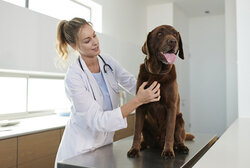If your dog is limping
If your dog shows signs of pain in joints or muscles, limps, or is not using any of its legs, this is known as lameness. In order to avoid permanent damage you should get the problem checked out by your vet at an early stage.
As soon as you notice that your pet is limping you should first inspect the affected leg i.e. the one that the pet is trying to avoid putting weight on. It could be that you notice swollen, warm or painful areas which could give an indication of where the problem could be. Look out for injuries in the sole area and remove any small foreign bodies in the foot such as spines, thorns or awns. Afterwards, the wound should be disinfected and bandaged by a vet. Larger foreign bodies such as shards of glass should only be removed by a vet as it can cause heavy bleeding.
Other reasons for lameness
Not all lameness is caused by acute trauma. As in humans, the causes range from a diversity of injury-related problems to developmental disorders such as hip dysplasia (HD) through to signs of wear and tear and ageing, particularly arthrosis. Lameness can also be caused by nerve and spinal conditions.
Joint injuries can lead to germs penetrating into the joint capsule and destroying the cartilage. Always consult your vet in such cases. Treatment at an early stage can lessen many problems and prevent long-term damage.
Correct nutrition for puppies
You can support the skeletal and cartilage development in dogs, especially young animals, by feeding your pet a balanced and high-quality petfood e.g. animonda GranCarno Junior. Puppies of larger dog breeds should not be fed diets which are too energy-rich as otherwise growth can be too quick, which can lead to overloading or incorrect loading of the growing skeleton. For this reason pay attention to the feeding recommendations on the packaging and orientate yourself according to recommendations on weight development of the respective breeding association.
Do not overstrain dogs
Young dogs, in particular, should also not be overstressed for example with long walks or getting them to run alongside your bike. Do not allow a dog with little training to frolic for hours with other dogs on fields, rather slowly get them used to playing with other dogs, for example by attending regular sessions at puppy and dog schools. For older dogs it is far better to go for several shorter walks than for a forced extended march every now and then. Over-exertion can lead to arthrosis and inflammation of the joints especially in older dogs.
You may also like this

Back problems in dogs
Back problems should be identified in good time

Feeding your puppy properly
A healthy diet is important for the growth phase

Gastric torsion in dogs
If you suspect this, take your dog to the vet immediately

Epilepsy in dogs
The cause of epileptic seizures should be investigated



